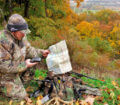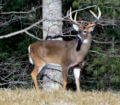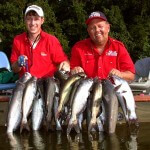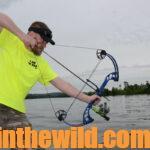Editor’s Note: If you’re hunting on private lands in states that consistently produce big bucks, you know how expensive leasing private land can be. You want to get the best land you can at the most-reasonable price. Once you get that property and know its ability to produce trophy bucks, you can manage the land to have trophy bucks to hunt every year. Kert Granier of Birmingham, Alabama, has bowhunted 300 acres in Schuyler County, Illinois, with several other bowhunters for a couple of years. They consistently take trophy bucks from that little patch of ground every year.
On the 300 rectangular-shaped acres my friends and I have leased to hunt, we have only about 110 acres of hardwoods that are huntable. The rest of the property is planted in crops every year – mainly soybeans or corn. We have very-little hunting pressure during bow season, and we provide sanctuary for the deer. On the northwest and southeast are big blocks of timber, about 110 acres. The rest of the property is a pinch point or corridor that deer use to move through these two big blocks of timber. A tight funnel on the southeastern portion of the property is where I like to hunt.
 About 6 weeks before deer season started, my friend David and I drove to the Illinois property and put up some fixed-position stands and trail cameras. Then when I reached the land, I put-up what I consider observation stands. I don’t like to sit in a tree stand, unless I’m very confident that a buck probably will pass by that stand. My observation tree stand allows me to sit a good ways away from the stand I’ll be hunting from and watch the amount of deer movement in and around my hunting stand. I saw about 25 deer on the south end of the cornfield where I had my hunting stand. I was able to determine where the deer were coming out of the timber, feeding in the agricultural fields and chasing does. I watched a monster 10-point buck mount a doe six different times. Apparently, the doe wasn’t ready to be bred. Thirty minutes before dark, a bigger 10-point came out in the field and chased all the does. But not finding a receptive doe, he eased back into the woods. That first afternoon, I saw 15 to 18 racked bucks from my observation stand.
About 6 weeks before deer season started, my friend David and I drove to the Illinois property and put up some fixed-position stands and trail cameras. Then when I reached the land, I put-up what I consider observation stands. I don’t like to sit in a tree stand, unless I’m very confident that a buck probably will pass by that stand. My observation tree stand allows me to sit a good ways away from the stand I’ll be hunting from and watch the amount of deer movement in and around my hunting stand. I saw about 25 deer on the south end of the cornfield where I had my hunting stand. I was able to determine where the deer were coming out of the timber, feeding in the agricultural fields and chasing does. I watched a monster 10-point buck mount a doe six different times. Apparently, the doe wasn’t ready to be bred. Thirty minutes before dark, a bigger 10-point came out in the field and chased all the does. But not finding a receptive doe, he eased back into the woods. That first afternoon, I saw 15 to 18 racked bucks from my observation stand.
I really believe, if you don’t hunt your tree stand on the first day of the hunt but instead set-up an observation stand well away from the stand you plan to hunt from, you’ll learn an awful lot about deer movement and patterns on the land, and identify which buck you can take, before you go to your stand and get ready to bowhunt. When I checked our trail cameras, I saw both 10-point bucks I’d seen out in the field that night. I decided to try and take the biggest 10-pointer. I knew my stand was where it needed to be for me to get a shot at two, nice-sized 10-point bucks, as well as about 17 smaller bucks.
I think one of the things that really help this property we hunt that’s a long way from where we live is the funnel present on it with big wood lots on either end and pinch points where agricultural and CRP fields neck-down the strip of timber. Also, we’ve created a sanctuary right in the middle of the property and never go into the sanctuary, where deer hold and bed. Because the funnel is a deep, thick gorge, the deer can go down into the sanctuary and get out of the wind. We always set-up our game plan to shoot the bucks going to or coming from the sanctuary. My hunting friends and I have learned that if you try and hunt the entire property, you’ll leave human scent throughout the area you’re trying to hunt. Then you’re less likely to get deer to stay on your property, than if you provide a sanctuary. The sanctuary is especially important as hunting pressure builds around the area we hunt. As other hunters walk around and move deer, they actually push the older, bigger bucks onto our land, which I think is one reason we see and take so-many big bucks. In the middle of the property, the deer have a sanctuary that never gets violated with human odor.
 On the first morning of my Illinois hunt, I saw quite a few 6, 7 and 8-point bucks and several groups of does passing within bow range. Spotting the groups of does excited me more than seeing the bucks. Since this region was barely in the rut, I knew that wherever the does were, the bucks would be there soon. Another advantage we had besides our observation stands that we used before the hunts was we also had good trail-camera pictures of several different shooter bucks coming by our stands. These two techniques helped us to decide which bucks we wanted to take.
On the first morning of my Illinois hunt, I saw quite a few 6, 7 and 8-point bucks and several groups of does passing within bow range. Spotting the groups of does excited me more than seeing the bucks. Since this region was barely in the rut, I knew that wherever the does were, the bucks would be there soon. Another advantage we had besides our observation stands that we used before the hunts was we also had good trail-camera pictures of several different shooter bucks coming by our stands. These two techniques helped us to decide which bucks we wanted to take.
About 10-minutes after good daylight, I looked to the edge of the property, watched a big buck jump the fence and then start walking down a mowed lane in a 40-yard wide strip of CRP land that came within 20 yards of my stand. I looked at the spot where I thought I would have a shot and ranged it at 26 yards. When the deer reached the opening, I was at full draw with my PSE bow https://www.pse-archery.com/. To stop him, I grunted. I released my Carbon Express arrow https://www.feradyne.com/carbon-express/ with a Rage Extreme broadhead and a Firenock (http://www.firenock.com/ that hit him behind the front shoulder and went into his offside leg. This buck was a main-frame 8-pointer, had a kicker off his left G2 and had been on our hit list for the year. He roughly scored about 135 on Pope & Young.
 Just before we bowhunt each year, the farmers cut the corn, leaving waste on the ground that the deer still can feed on, but the deer have to find a new place to bed. Deer from surrounding farms also bed in our sanctuary. When the farmer plants soybeans, they can feed in the soybeans, bed in the sanctuary and have food and cover throughout most of the year.
Just before we bowhunt each year, the farmers cut the corn, leaving waste on the ground that the deer still can feed on, but the deer have to find a new place to bed. Deer from surrounding farms also bed in our sanctuary. When the farmer plants soybeans, they can feed in the soybeans, bed in the sanctuary and have food and cover throughout most of the year.
However, once the rut begins, and the bucks start chasing the does, they may run the does out into the clear fields. Most of the time, they’ll chase the does out of the sanctuary and through the narrow block of timber into the bigger woods on either end of the timber that we hunt. So, we have ideal habitat, food and cover for the deer on our land. We’ve hunted this land for a couple of years now and have learned a lot about the deer there. The landowner will mail us our trail camera cards after we make a trip a couple of months before deer season to the land and set-up our trail cameras.
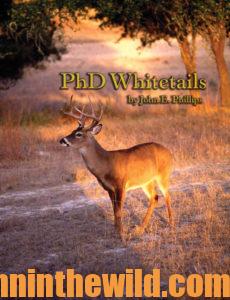
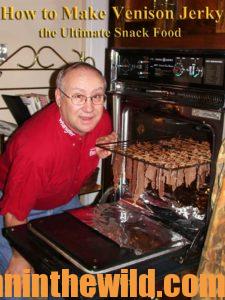 To learn more about hunting deer, check out John E. Phillips’ book, “PhD Whitetails: How to Hunt and Take the Smartest Deer on Any Property,” available at https://www.amazon.com/dp/B007A2N792. To receive your free book on “How to Make Venison Jerky,” go to https://www.emailmeform.com/builder/form/Ece3UZVcOo52cKPJcL
To learn more about hunting deer, check out John E. Phillips’ book, “PhD Whitetails: How to Hunt and Take the Smartest Deer on Any Property,” available at https://www.amazon.com/dp/B007A2N792. To receive your free book on “How to Make Venison Jerky,” go to https://www.emailmeform.com/builder/form/Ece3UZVcOo52cKPJcL

